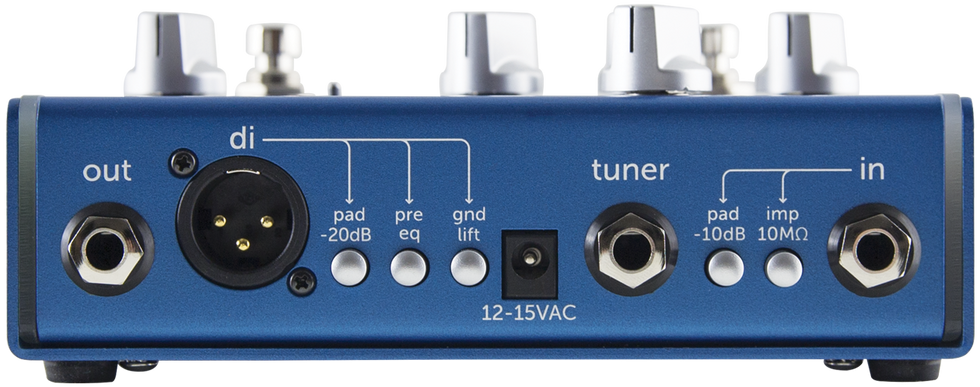Recorded direct into Focusrite Saffire 6 interface into MacBook Pro using Logic.
Clip 1: ‘64 Fender Jazz with both pickups engaged and tone at 50 percent—mid and bass boosted on StarLifter with contour off. Switched to vintage contour at :11.
Clip 2: Squire HH Contemporary Jazz with both pickups engaged and tone at 100 percent—mid and bass boosted on StarLifter with contour off, then modern at :11, and vintage at :21.
RatingsPros:Effortless tone shaping, practical contour settings, and a robust DI. Cons: Requires a 12-15V AC adaptor. It’s not light. Street: $349 Rocket Surgeon StarLifter nordstrandaudio.com | Tones: Ease of Use: Build/Design: Value: |
Carey Nordstrand has been making a significant imprint on the bass community since he opened the doors to Nordstrand Audio in 2005. While respected for his finely crafted instruments, it’s his pickup designs that launched him into the low-end stratosphere. Today, Nordstrand is also making a mark further down the signal chain with Rocket Surgeon, his series of bass and guitar effects pedals. Most recently, the line was enhanced with the introduction of the StarLifter, a bass preamp/DI pedal with simple features and stout tone.
Celestial Being
The planetary themed StarLifter’s layout is quite intuitive. Nordstrand’s 3-way contour switch lays a timbral foundation, from a scooped sound with a bass and treble boost (modern) to a punchy, mid-friendly vintage setting. The switch can also be disabled for a colorless presentation of the instrument. Tone shaping is achieved through its 3-band EQ, and expanding the EQ’s flexibility is a mid-frequency control—essential for dialing in preferred midrange tastes. A right-side-located volume dial to balance the signal rounds out the control set.Nordstrand injected some practical fun into the StarLifter by installing light bars on opposite sides of the box to indicate activity: Engaging the pedal turns the bars green, while muting the box shifts the bars bright red.
Most preamp/DI pedals house switches for pre/post EQ, ground lift, and padding the signal, but the StarLifter also added two other components that make it stand out. An impedance switch adjusts the input to 1-megohm or 10-megohm operation, which is crucial for optimizing the pickups of different instruments. High outputs can be tempered with a second pad switch, which is located after the input and impedance section. Speaking of output, it should be mentioned that the StarLifter sends an output strong enough to drive a power amp or powered speaker.
Cosmic Explorer
I was surprised, at first, by how heavy the StarLifter felt in my hand. It’s not a big deal if it’s being used as a standalone pedal, but at 2 1/2 pounds, it could make schlepping a pedalboard a bit more cumbersome. Regardless of any possible transport concerns, the extra mass instills confidence that Rocket Surgeon’s latest is a rugged pedal. Batteries won’t add to the weight since the StarLifter is not designed for battery power. It runs on an included 12-15V AC adaptor. This could be problematic if you forget to pack the provided wall wart, so, well, don’t forget to pack the provided wall wart.
Despite these minor concerns, this blue box absolutely excels in the tone department. I explored the StarLifter’s functions in my studio through a Bergantino rig—comprised of a B|Amp head and HD112 cab—and connected the pedal through the return jack on the rear of the amp. A 1964 Fender Jazz bass and a Fender PJ Elite were the basses of choice.
One of the most important characteristics of a preamp/DI pedal is that, when in its “flat” setting, the inherent qualities of an instrument are preserved. I was pleased to hear no significant difference in tone when alternating between the inputs of the B|Amp and StarLifter. In my experience, few preamps at this price achieve this level of transparency.
The EQ is easy to operate, due in part to the way Rocket Surgeon voiced the three bands. There is an ample amount of boost and cut (+/- 15 dB) to provide enough booty or brightness without over-coloring the sound. I found the mid EQ to be particularly beneficial, as I was able to dial in the ideal frequency from 150 Hz to 2.8 kHz to add bump to the flatwound strings on my Jazz, or beef up the bark of the Elite PJ’s bridge pickup.
Pino or Jaco?
Pre-shape settings are nothing new in preamp features, but the StarLifter’s contour switch could arguably be the best on the market. The scooped modern mode is a slapper’s delight, as it’s handy for a quick EQ shift for on-the-fly thumb slinging. Also, one of my favorite features of the StarLifter pedal is the vintage setting, for how it added a perfect touch of syrup to the tone of my basses. Using the vintage contour setting in conjunction with the 10 megohm input impedance gave the sweet tone a quick attack. Pino and Jaco disciples will appreciate this combination.

In Nashville’s Lower Broadway bars and honky-tonks, backline often takes a beating, and the din of bickering bachelorettes, car horns, and neighboring bar bands can provide a wealth of sonic challenges. So, I took the StarLifter along to play shows with both a country/rock group and a hip-hop tribute band. The pedal was plugged into a couple different rigs including a Fender Rumble 500 and a Gallien-Krueger 1001RB (each with EQ set flat), and both clubs supplied a Gallien-Krueger Neo 412 cabinet. A Squier Contemporary HH Jazz bass and a Steinberger NXT electric upright were the selected test instruments.
While much of my studio experience with the StarLifter was confirmed in the live settings, there were a few takeaways that increased my appreciation for the pedal. The sound people at both clubs were impressed with StarLifter’s DI, and remarked how its full and clean presentation of tones required little adjustment on their end. From a performance perspective, the 10 megohm input gave the Steinberger EUB a pronounced attack, and the vintage contour setting warmed the deceptively acoustic tonality of the bass.
The Squier was rewarded with increased versatility, as a boost in the bass and midrange delivered a deeper fundamental to the modern-sounding instrument. Engaging the vintage mode beefed up the neck and bridge pickup when needed, but turning the contour switch to the modern position quickly returned the Squier to an on-call slap machine. In both live settings, I appreciated how the StarLifter permitted me to establish a strong foundation within the mix, so I could focus less on my gear and more on making music.
The Verdict
It’s a bit pricey, a tad heavy, and unconventionally powered, but the StarLifter also has the makings to be an almost indispensable device for one’s signal chain. It’s not often I have a pedal that compels me to use it at every show, but the simple features and robust tonal production inspired me to make room for the StarLifter in my gig bag. Rocket Surgeon has made a strong impression with the StarLifter and, for this bassist, it’s a definite contender for best-in-class.







![Rig Rundown: AFI [2025]](https://www.premierguitar.com/media-library/youtube.jpg?id=62064741&width=1245&height=700&quality=70&coordinates=0%2C0%2C0%2C0)












 Shop Scott's Rig
Shop Scott's Rig















































